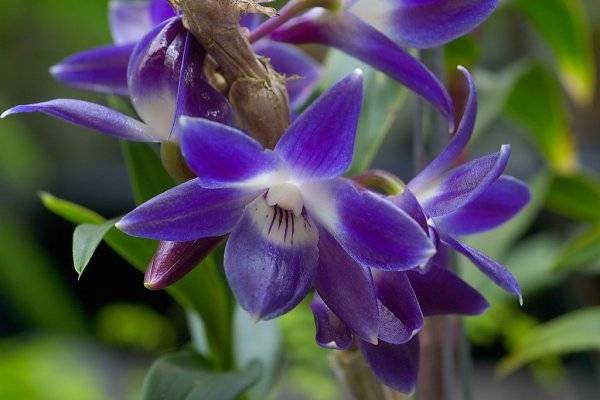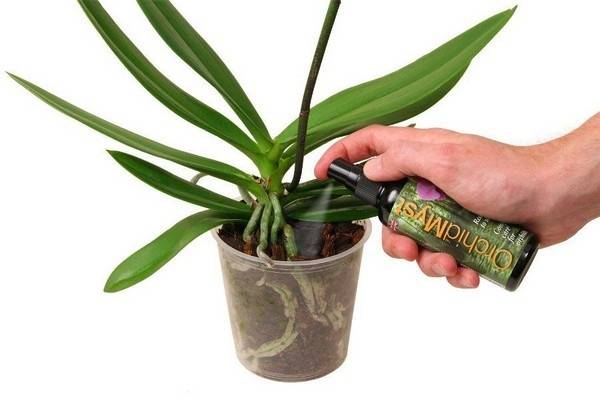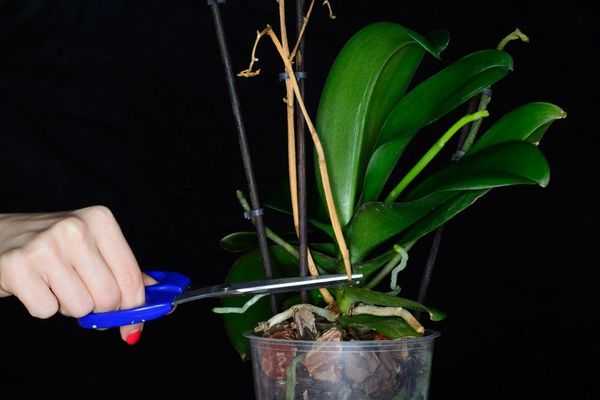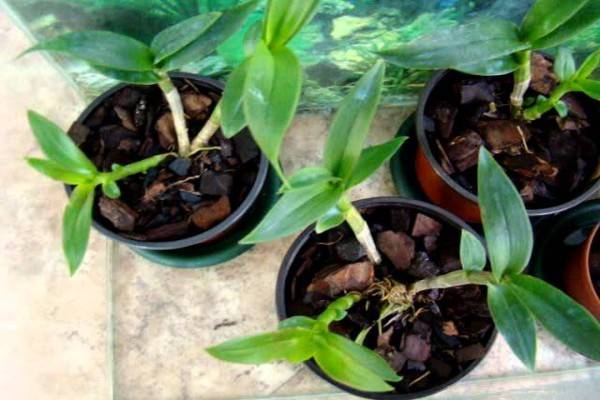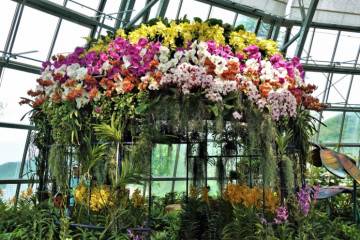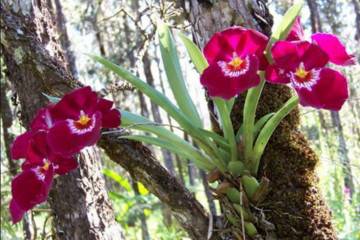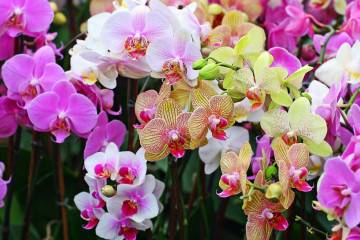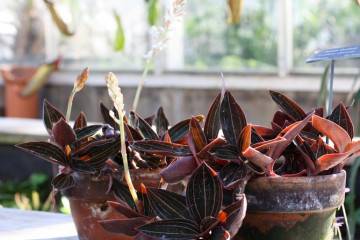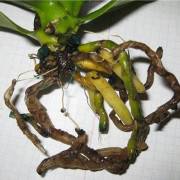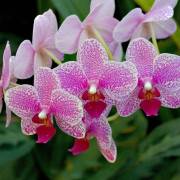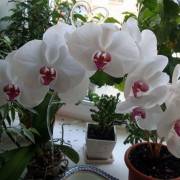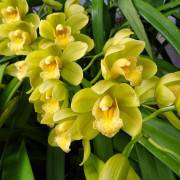Dendrobium orchid - home care
Content:
Judging by the reviews on various forums, the dendrobium orchid is the second most popular after phalaenopsis. However, even now flower lovers do not know many facts about this plant. For regular flowering and obtaining a luxurious plant, you must follow the rules of care. This will be discussed further.
What does a dendrobium orchid look like?
The dendrobium flower is a member of the Orchid family. It grows naturally in the Himalayas, Vietnam, China, Indonesia. Small plants - 40-90 cm, with a stem consisting of cylindrical pseudobulbs.
Lanceolate foliage is located on the stem in turn, peduncles emerge from the deciduous sinuses, each with from 1 to 4 flowers. Orchids are painted in white, yellow, orange shades, there are two-color and three-color.
Common varieties of orchids
The following species are grown at home:
- orchid dendrobium Nobile or "noble" (dendrobium nobile) - 50-90 cm high, it has large peduncles, up to 60 flowers appear at the same time;
- orchid phalaenopsis giant (giganteum) - the largest representative of tree varieties, with leaves up to 1 m in length, from 10 to 30 flowers are formed on the peduncle;
- Kinga (kingianum) - grows 8-65 cm, buds with snow-white, pink and red shades, the flower was named in honor of the British admiral;
- dendrobium quadrangular (Dendrobium tetragonum) - growth from 5 to 50 cm, whimsical care, requires a period of rest;
- dendrobium aberrans (Dendrobium aberrans) - a feature of the Aberans variety is the absence of requirements during the dormant period to stimulate the development of buds.
There are many hybrids on sale (for example, dendrobium berry ode), natural varieties - in the botanical garden or in the collections of flower lovers.
According to some historians, in ancient times, about 3-4 thousand years ago, mix orchids belonged to medicinal plants.
Features of caring for a flower at home
Caring for a dendrobium orchid at home means creating conditions close to natural growth. Violation of the rules can lead to disease and death of the culture.
Temperature
In spring and summer, the plant actively develops, releasing young shoots and accumulating moisture and nutrients in pseudobulbs. At this time, it is necessary to observe a certain temperature regime:
- in spring - from 20 to 24 degrees;
- in summer - up to 27 degrees.
At a temperature of 30 degrees, instead of blooming, the plant begins to form babies.
In autumn and winter, the culture needs rest. The plant is sent to a room with a temperature of 15-18 degrees, the frequency of watering is reduced, the air humidity is increased to maximum levels.
Lighting
The flower prefers bright and diffused light, direct exposure to sunlight causes burns on the leaves.In the autumn-winter period, phytolamps are used - they will increase the daylight hours to 12 hours.
The pots are placed on the east, southwest, and north windowsills.
Lack of light is the main reason for the plant to hibernate and temporarily stop growth and development.
Watering
With the active development of culture, abundant moisture of the earth is necessary. Experienced florists advise:
- make sure that there is no waterlogging of the root system;
- between procedures, the earthen lump must dry completely;
- it is better to irrigate with rainwater or a mixture of tap water with distilled water, in a ratio of 1 to 1.
The increased salt content in the liquid can destroy the orchid.
During growth and development, the soil is moistened twice a week, in autumn - once every 7 days, in winter - monthly.
Spraying
It is used at constant low air humidity. In addition to daily spraying, it is necessary to regularly moisten expanded clay, spread sphagnum moss on the sand.
The plant prefers moisture values at 55-60%. If there is a lack of moisture, you can put a glass of water near the flower.
Priming
It is better to use ready-made soil mixtures intended for epiphytic crops or orchids.
For self-preparation of the soil, use:
- old pine bark - covers 1-3 cm in a box;
- charcoal;
- garden land;
- fern roots;
- coconut fiber or bottle caps.
Top dressing
During the growing season, feeding is carried out from April to September. A special fertilizer for orchids is used, the procedure is combined with watering.
Before the formation of buds, the culture is fed exclusively with potassium-phosphorus fertilizers.
Features of care in winter, dormant period
Winter home care for dendrobium lasts two months:
- after the last decade of November, irrigation is stopped;
- the flowerpot is sent to a light and dry room;
- maintain the temperature at 15-16 degrees, at night it can be reduced to 10 degrees.
When and how it blooms
The orchid blooms in the spring and summer, subject to the regime:
- when creating temperature fluctuations in the range of 5-6 degrees;
- increased daylight hours;
- dressings with a high nitrogen content;
- after three warm showers when the water is heated from 30 to 35 degrees.
Pruning
The pseudobulb is removed after drying - during the development of the buds, it gives up all the water and nutrients.
If there are unopened flowers on the peduncle, then pruning is not carried out - they will bloom after a while.
How the dendrobium orchid reproduces
You can propagate by cuttings, children or dividing the bush. Each procedure has its own characteristics.
Germinating seeds
Seed propagation is practically not used because of the need for special skills and knowledge.
Sowing seeds on a nutrient medium is good in the laboratory, not at home. Maintaining sterility in an apartment is practically impracticable.
Rooting cuttings
A pseudobulb is separated from the mother bush (the plant must bloom), which is divided into separate parts (10 cm long). Places of cuts are treated with an antiseptic composition, the cuttings are sent to a plastic bag and filled with moss.
Over the course of several months, the root system will develop; to obtain good results, airing and periodic moistening are carried out daily. The house should be warm and light.
Air layering
Children appear at the top of the pseudobulb, separation is carried out after the formation of a separate root system.
After the development of roots up to 5 cm, the layers are cut or separated by twisting around their own axis. The new plant is dried for several days or the cut site is treated with garden pitch.
Other options
The division of the bush is possible only in strong and adult individuals. The resulting parts are immediately transplanted into separate boxes.
The mother tuber must be cut according to certain rules:
- there should be several pseudobulbs on each site;
- a young sprout is present on a separate pseudo-bulb.
Transfer
Transfer work is carried out rarely and only as needed:
- every three years;
- with decomposition or excessive compaction of the soil;
- with increased acidity or decay of the substrate.
Orchids do not respond well to transplantation and may die if the procedure is not performed correctly.
Diseases and pests
The plant is often attacked by aphids, spider mites or thrips. The fight against parasites includes increasing the humidity of the air, washing the green part with soapy water, and mechanically cleaning the foliage from parasites. For serious injuries, insecticides are used.
If the orchid is not properly cared for, the plant may show the following symptoms:
- shriveled stems - insufficient watering;
- yellow and falling foliage - rotting roots, overfeeding, temperature changes, lack of water;
- rotten root system - watering in winter, constantly wet substrate, poor soil;
- falling flowers - pests or high temperature;
- marble or light green color of the leaves - insufficient intake of magnesium and iron.
Fulfillment of the requirements specified in the description of orchid care will avoid diseases and flower death. Proper watering, sufficient lighting and periodic feeding will allow you to enjoy the unusual beauty of flowers several times a year. For beginners, it is better to choose unpretentious varieties that do not require periods of rest and activity.

